Home Improvement
Maximize Space and Organization in Your Home With These Genius Tips!
Harness the power of clever organization tips to transform your home into a spacious oasis—discover how inside!
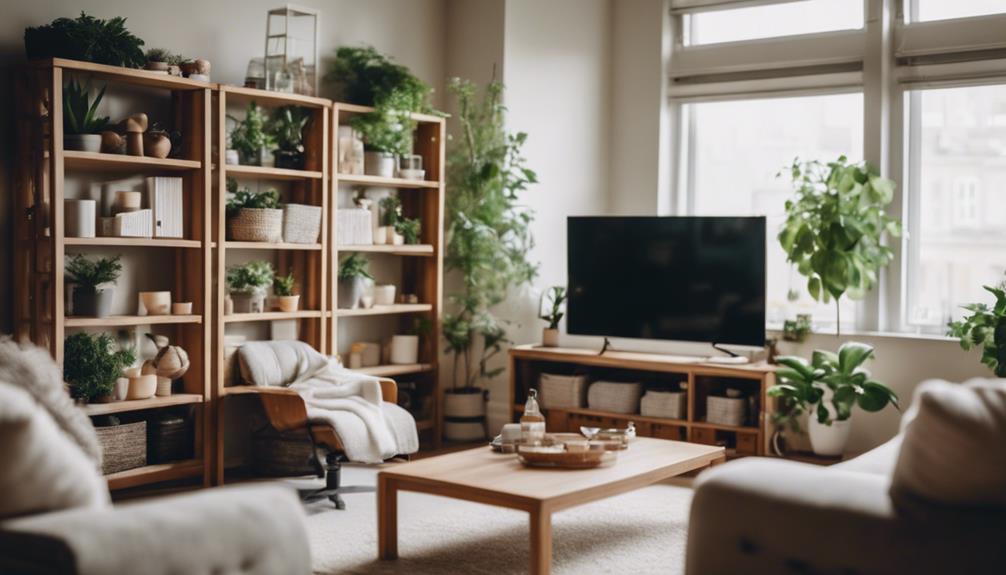
You can easily maximize space and organization in your home with a few clever tips. Start by embracing vertical storage through shelves and hooks to free up floor space. Opt for multipurpose furniture like sofa beds and storage ottomans to save room while staying functional. Don't forget under-bed storage for seasonal items and shoes. Organize your closets with cascading hangers and clear bins for visibility. In the kitchen, magnetic strips can keep utensils at hand while reducing clutter. By implementing these strategies, you'll start enjoying a more spacious and organized home. Keep exploring for even more brilliant ideas!
Key Takeaways
- Embrace vertical storage by installing shelves and wall-mounted organizers to free up floor space and keep items accessible.
- Utilize multipurpose furniture, such as storage ottomans and sofa beds, to maximize functionality while minimizing clutter.
- Optimize under-bed storage with bins and vacuum-sealed bags to reclaim space in closets and other areas.
- Organize closets with cascading hangers and clear bins to enhance visibility and prevent clutter accumulation.
Embrace Vertical Storage
To maximize your home's storage potential, embrace vertical storage by installing shelves and wall-mounted organizers that keep your floor space clear. This approach not only enhances your storage capacity but also creates an organized environment where everything has its place. By utilizing vertical surfaces, you can easily access frequently used items and improve the overall functionality of your rooms.
Consider tall bookshelves for books and decorative items, or pegboards for tools and craft supplies. These stylish vertical storage solutions not only declutter your surfaces but also add visual interest to your space. Hanging baskets and bins on walls are another great way to store smaller items, keeping them off counters and tables while creating an eye-catching display.
When you embrace vertical storage, you're cultivating a habit of organization that encourages you to keep your belongings in designated spaces. This organization system helps maintain a cleaner, more inviting home, making it easier for you to find what you need, when you need it.
Transform your living space by maximizing every inch of vertical real estate available.
Optimize With Multipurpose Furniture
Multipurpose furniture often transforms small spaces into efficient, functional areas that meet various needs without cluttering your home. By incorporating these versatile pieces, you can maximize functionality while keeping your living environment organized.
Here are three great examples of multipurpose furniture for small spaces:
- Sofa Bed: This dual-purpose piece serves as a comfortable couch during the day and converts into a bed for guests at night, saving you the hassle of an extra guest room.
- Storage Ottoman: An ottoman with hidden storage allows you to tuck away blankets, books, or games, doubling as a stylish coffee table while reducing clutter.
- Foldable Dining Table: A dining table that easily transforms into a workspace gives you flexibility to enjoy meals or tackle projects without needing additional furniture.
Utilize Under-Bed Storage

Utilizing under-bed storage can turn wasted space into a valuable resource for keeping your home organized and clutter-free. This often-overlooked area is perfect for storing items like shoes, seasonal clothing, or extra bedding. You can use rolling bins or vacuum-sealed bags to maximize space effectively.
If you want to enhance your under-bed storage, consider using bed risers. These can increase under-bed clearance, allowing for larger storage containers, which means you can store even more items. Many under-bed storage solutions are designed to fit standard bed dimensions, providing a seamless fit that doesn't compromise your room's aesthetics.
Investing in containers specifically designed for under-bed storage helps keep your items organized, dust-free, and easily accessible. This not only promotes a clutter-free environment but also helps you reclaim valuable space in your closets and other areas.
Organize Closets Effectively
Organizing your closet effectively can transform it into a functional space that makes finding your favorite outfits a breeze. To maximize both space and organization, consider implementing these three tips:
- Cascading Hangers: These clever hangers save vertical space, allowing you to see all your clothes at a glance while keeping them easily accessible.
- Over-the-Door Organizers: Don't overlook the back of your closet door! Use it to store shoes and accessories, creating additional storage without taking up floor space.
- Shelf Dividers: Installing dividers on your shelves helps keep your items neatly organized and prevents clutter from taking over, making it easier to find what you need.
Additionally, clear storage bins can enhance visibility, allowing you to quickly identify contents without rummaging through everything.
If you're looking for a more customized solution, consider a closet system with adjustable shelves and rods tailored to your needs.
With these strategies, you'll not only increase space but also bring a sense of organization to your closet that will make dressing up enjoyable every day.
Implement Kitchen Storage Hacks
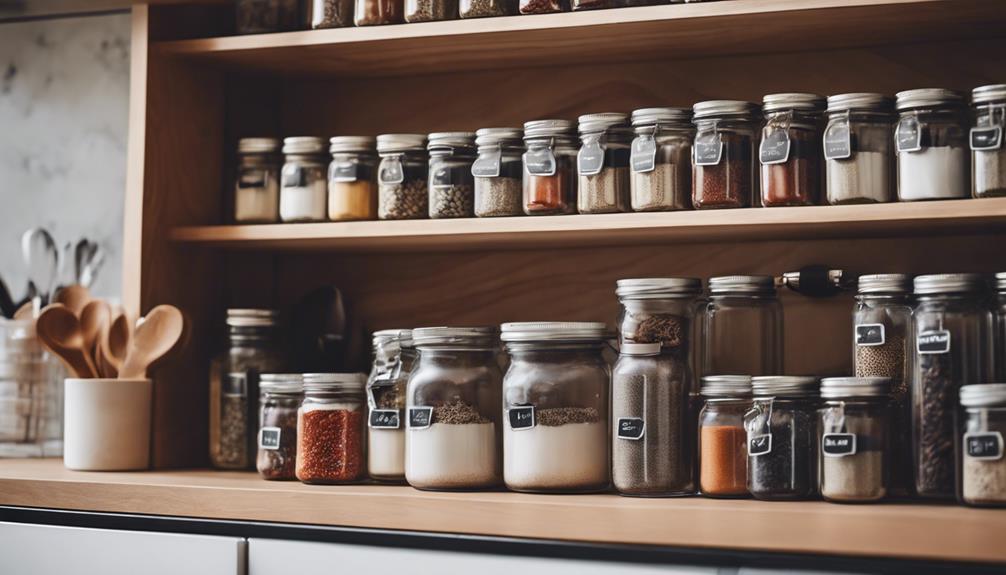
When it comes to maximizing your kitchen space, magnetic strip solutions and pull-out shelves can make a world of difference.
You can easily free up counter space and keep your utensils organized with a simple strip on the wall.
Plus, pull-out shelves let you reach those hard-to-find items, ensuring every inch of your cabinets is used efficiently.
Magnetic Strip Solutions
Magnetic strips transform your kitchen by securely holding spice jars, utensils, and knives, freeing up valuable counter space. If you're in a small space and looking for ways to maximize organization, this solution is a game-changer. Even a professional organizer would agree that magnetic strips offer an efficient way to keep your essentials within reach and neatly displayed.
Here are three clever ways to utilize magnetic strips in your kitchen:
- Spice Jar Storage: Attach a magnetic strip to the wall or inside a cabinet to hold your spice jars. This keeps them visible and accessible while cooking, saving you time and hassle.
- Metal Utensil Storage: Install a magnetic strip under your cabinets to hang metal utensils. This reduces drawer clutter, making it easier to find what you need.
- Knife Organization: Use a magnetic strip to safely store knives on the wall, keeping them out of drawers and ensuring they're easily accessible.
Pull-Out Shelf Benefits
Pull-out shelves revolutionize kitchen storage by providing easy access to deep cabinet spaces, making it simple to reach items tucked away in the back. These shelves can increase your usable space by up to 50%, allowing you to store items like pots, pans, and pantry supplies more efficiently. With everything in sight, you'll experience Big Organization in your kitchen.
One of the biggest benefits of pull-out shelves is their accessibility. If you have mobility issues, these shelves drastically reduce the need to bend down or reach high, making your kitchen much easier to navigate. You can customize these shelves to fit various cabinet sizes and depths, ensuring they meet your unique storage needs.
Moreover, installing pull-out shelves can dramatically improve your kitchen's organization. They help prevent clutter by providing designated spots for your items, enabling you to find what you need quickly. This not only saves time during meal prep but also enhances your overall cooking experience.
Enhance Bathroom Organization
Enhancing your bathroom organization can transform it into a more functional and enjoyable space. By simplifying your life with smart storage solutions, you can create a clutter-free environment. Here are three easy ways to enhance organization in your bathroom:
- Utilize Drawer Dividers: Keep toiletries and makeup neatly organized. This makes it easy to access items without rummaging through clutter.
- Install Shelves Above the Toilet: Maximize your vertical space. These shelves can hold towels, toiletries, or decorative elements, adding both function and style.
- Use Shower Caddies: Keep bath products organized and within reach. This method reduces countertop clutter and enhances accessibility, making your shower experience more enjoyable.
In addition to these tips, consider incorporating baskets for towels and linens. They not only keep your essentials stored but also elevate your bathroom's decor.
Create Entryway Solutions
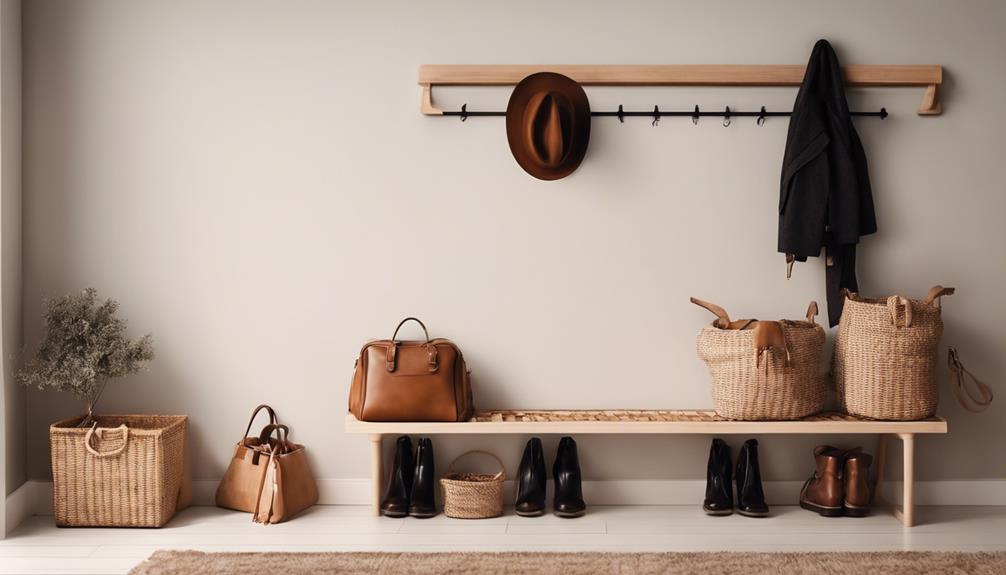
Your entryway sets the tone for your home, so creating effective solutions is key.
Start by installing a wall-mounted coat rack to keep jackets and bags organized.
Then add shoe storage to minimize clutter.
Don't forget to incorporate key and mail organizers to keep essential items within reach and tidy.
Wall-Mounted Coat Racks
Wall-mounted coat racks are a smart solution for maximizing entryway space, allowing you to keep coats, bags, and accessories neatly organized while freeing up valuable floor area. By utilizing vertical space, you can make even the smallest entryways functional and clutter-free.
Here are three benefits of installing wall-mounted coat racks:
- Space-saving design: These racks don't consume precious floor space, making them perfect for apartments or smaller homes.
- Enhanced organization: Many options come with hooks for keys or shelves for mail, giving you designated spots for essential items.
- Stylish addition: Available in various styles and materials, wall-mounted coat racks can seamlessly blend with your decor, adding both function and aesthetic appeal.
Installing a wall-mounted coat rack is a quick DIY project that requires minimal tools and time.
You'll not only improve organization in your entryway but also create a welcoming environment for you and your guests.
With this simple addition, you can transform your entryway into an organized and stylish space that reflects your personal taste.
Shoe Storage Options
Shoe storage solutions can transform your entryway into an organized space, making it easy to keep footwear accessible and tidy. Start by adding a shoe rack or bench, which not only organizes your shoes but also provides a convenient spot for putting them on or taking them off.
If you're short on floor space, consider using over-the-door shoe organizers. These maximize vertical space and keep your shoes off the ground.
For seasonal or less frequently used footwear, clear storage bins or labeled containers can simplify identification and access. You can also incorporate a decorative basket or bin at the entryway for everyday shoes, blending functionality with style.
To further enhance organization, implement a shoe rotation system. Store off-season shoes in vacuum-sealed bags, saving space and reducing clutter in your entryway.
Key and Mail Organizers
Creating a designated spot for keys and mail can greatly reduce clutter and streamline your daily routine in the entryway. By implementing key and mail organizers, you'll be amazed at how much easier life becomes.
Look around your space and consider these three practical solutions:
- Wall-Mounted Hooks: Install hooks near the door for keys and small accessories. This keeps them visible and easily accessible, preventing the frantic search before heading out.
- Labeled Baskets or Trays: Use stylish baskets or trays for incoming and outgoing mail. Label them to guarantee you know where everything goes, helping you maintain an organized entryway.
- Narrow Console Table: Add a console table with storage options to hold mail, keys, and other essentials. This not only provides a tidy solution but also enhances your entryway's aesthetic.
Maximize Living Room Space
Maximizing your living room space can transform it into a more functional and inviting area. Start by incorporating multi-functional furniture. A multi-functional coffee table with built-in storage can keep remotes and magazines organized while serving as a central gathering spot. Additionally, consider using storage ottomans that double as seating and provide hidden compartments for blankets or games.
To create a sense of openness, arrange your furniture thoughtfully. Position larger pieces against the walls to allow for clear pathways throughout the room. This enhances flow and makes the space feel larger. Don't forget to utilize vertical space—install floating shelves to display books and decor. This frees up floor space and adds visual interest.
Consider using decorative baskets or bins to corral miscellaneous items, maintaining a tidy appearance while ensuring easy access to frequently used things.
Here's a quick reference table to guide you:
| Tip | Benefit |
|---|---|
| Multi-functional coffee table | Keeps items organized and accessible |
| Storage ottomans | Provides seating and hidden storage |
| Floating shelves | Frees floor space and adds decor |
Frequently Asked Questions
What Are 5 Ways to Arrange and Organize Your Space at Work?
To organize your workspace effectively, create functional zones, utilize vertical storage, incorporate multipurpose furniture, implement a labeling system, and maintain a regular decluttering schedule. These strategies enhance productivity and keep your area tidy.
How to Improve Organizational Skills at Home?
To improve your organizational skills at home, try implementing the One-In, One-Out rule, create functional zones for activities, use vertical storage solutions, schedule regular decluttering sessions, and involve your family in maintaining order.
How to Organize Every Space in Your House in 8 Simple Steps?
So, you think organizing your house is as easy as pie? Start by decluttering, embrace vertical storage, utilize multipurpose furniture, and set a daily routine. Trust me, your future self will thank you!
How to Make Your Home More Organized?
To make your home more organized, start by decluttering regularly, implementing vertical storage solutions, and using multipurpose furniture. Organize closets effectively, and adopt the One In, One Out rule to manage your belongings.
Conclusion
So, go ahead—turn your home into a glorious maze of vertical shelves and multipurpose furniture that doubles as a spaceship!
You'll be maneuvering around your living room like Indiana Jones, dodging under-bed treasures and closet booby traps.
Who needs a clear path when you can have a labyrinth of cleverly hidden clutter?
Just remember, if you can't find your couch, at least you've maximized every inch of space!
Happy organizing, oh master of chaos!
Mason – Your Product Expert Mason is your go-to product expert, carefully selecting each item in our collection to ensure it meets your comfort, functionality, and style needs. With his attention to detail and commitment to quality, he ensures that every product we offer enhances your home experience.
Home Improvement
DIY Closet Organization Systems
Get inspired to transform your closet with DIY organization systems that maximize space and style—discover the secrets to a clutter-free haven!
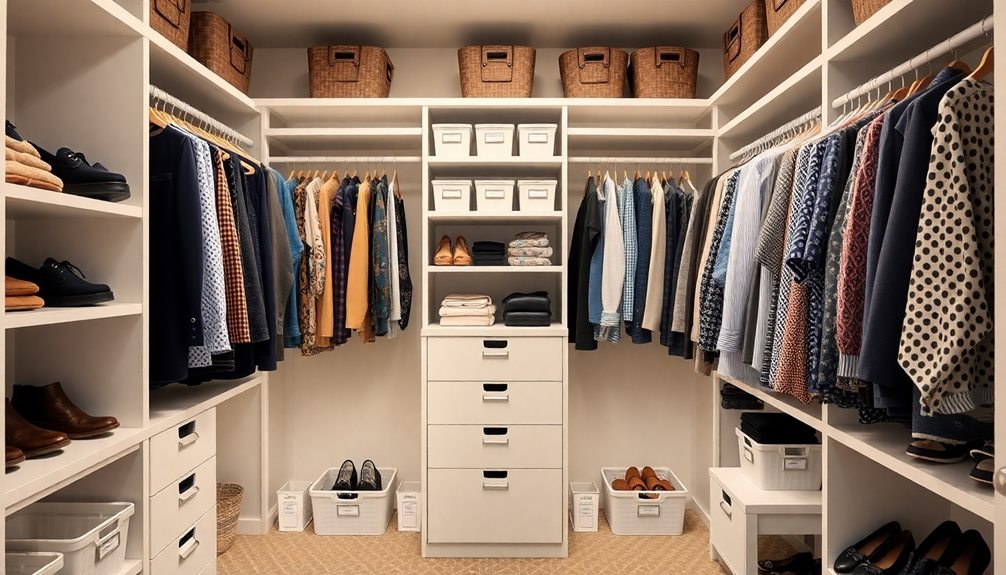
Creating your own DIY closet organization system can completely revamp your cluttered space. Start by gathering materials like MDF boards and a wooden closet rod. Use tools such as a tape measure and a circular saw for precise cuts. Measure your closet dimensions carefully and plan your design to maximize vertical space. Incorporate shelves, rods, and cubbies for versatility. Don't forget to paint and finish your system for a polished look. With these tips, you can make a stylish and efficient storage solution that suits your needs. Discover more ingenious ideas to elevate your closet organization!
Key Takeaways
- Measure closet space accurately, including back and side walls, to ensure a perfect fit for your organization system.
- Use wood boards, hanging rods, and cubbies to create a customized storage solution tailored to your needs.
- Incorporate vertical storage options like shelves and over-the-door organizers to maximize space efficiency.
- Utilize a Kreg Jig for pocket holes and screws to ensure a sturdy and durable assembly of your closet system.
- Finish with paint and trim for a polished look, ensuring to pre-paint hard-to-reach areas for ease of maintenance.
Materials Needed for DIY Closets
When you're diving into your DIY closet organization project, having the right materials is essential for success. Start with five 1x12x8 MDF boards; they'll provide a sturdy foundation for your DIY closet organizer.
Next, grab five 1x2x8 common boards, preferably pine, for the outer face. This choice not only enhances the look of your closet organization system but also keeps costs down.
Don't forget about optional shoe storage! Incorporate two 1×1 square dowels for cubbies that can neatly hold your favorite pairs.
For the top shelf supports, consider using two 1x4x12 boards, and if you're looking to save, scrap wood can work just as well.
Lastly, you'll need a wooden closet rod or a reusable, affordable 1.25 round dowel for hanging clothing. This element is vital for any functional closet organization system.
With these materials on hand, you're well on your way to creating a stylish and practical DIY closet organizer that meets your needs. So gather your supplies, and let's get started on transforming your closet into a space that works for you!
Tools for Closet Organization

When organizing your closet, having the right tools makes all the difference.
You'll need measuring and cutting tools to guarantee everything fits perfectly, along with assembly equipment for a sturdy build.
Don't forget your safety gear to keep yourself protected while you work!
Essential Tool Selection
Selecting the right tools is vital for a successful closet organization project. First on your list should be a tape measure. This tool will help you accurately measure your closet dimensions, guaranteeing that all components fit properly.
A circular saw is next; it's imperative for making precise cuts on wood boards, so you can achieve the exact dimensions needed for your organization system.
Don't forget a Kreg Jig, which is invaluable for creating pocket holes. These provide sturdy joints for assembling shelves and supports, assuring your system is durable.
If you're looking to speed up the assembly process, consider investing in a nail gun. It allows you to quickly fasten pieces together, although a hammer and nails can work just as well if you prefer a more traditional approach.
Lastly, a level is a must-have to verify everything is straight. Proper installation prevents items from sliding off and keeps your closet looking neat.
With these essential tools—tape measure, circular saw, Kreg Jig, nail gun, and level—you'll be well-equipped to tackle your closet organization project effectively. Happy organizing!
Measuring and Cutting Tools
Accurate measurements are the backbone of any successful closet organization project. To achieve this, grab a tape measure and a combination square. These tools will guarantee you get precise dimensions for all your closet organizers.
Once you've measured everything, you'll need cutting tools to transform your materials. A circular saw or miter saw is essential for cutting wood to the required lengths, providing clean and straight cuts that ensure stability.
After cutting, it's vital to install your shelves and supports evenly. Using a level tool will help you verify that everything is straight, preventing sagging and giving your closet a professional look.
Additionally, a drill with the appropriate drill bits is necessary for creating pocket holes and securing screws. This step enhances the durability of your assembled pieces, guaranteeing they stand the test of time.
Don't forget to prioritize safety while working with these cutting tools. Always wear safety gear, including goggles and dust masks, to protect yourself from debris and dust generated during the measuring and cutting process.
Assembly and Safety Equipment
As you immerse yourself in assembling your DIY closet organization system, having the right tools and safety equipment is vital for a smooth and efficient process.
Start with a stud finder to locate the wall studs; this is critical for securely attaching shelf supports. Proper attachment guarantees stability and durability for your organizer.
Next, you'll need a level tool to verify your shelves are installed evenly. This prevents sagging and enhances the overall look of your closet.
For cutting wood, consider using a miter saw or circular saw, as they provide accurate cuts. A Kreg Jig can help you create pocket holes for a sturdier assembly, while a nail gun will speed up the process by quickly securing pieces together.
Don't forget about safety equipment! Always wear safety glasses to protect your eyes from debris, hearing protection to shield against noise, and a dust mask to keep out fine particles when cutting MDF or plywood.
Regularly maintain your tools, confirming blades are sharp and drills are functional. This attention to detail not only helps you work efficiently but also keeps you safe throughout your DIY project.
Steps to Measure Closet Space
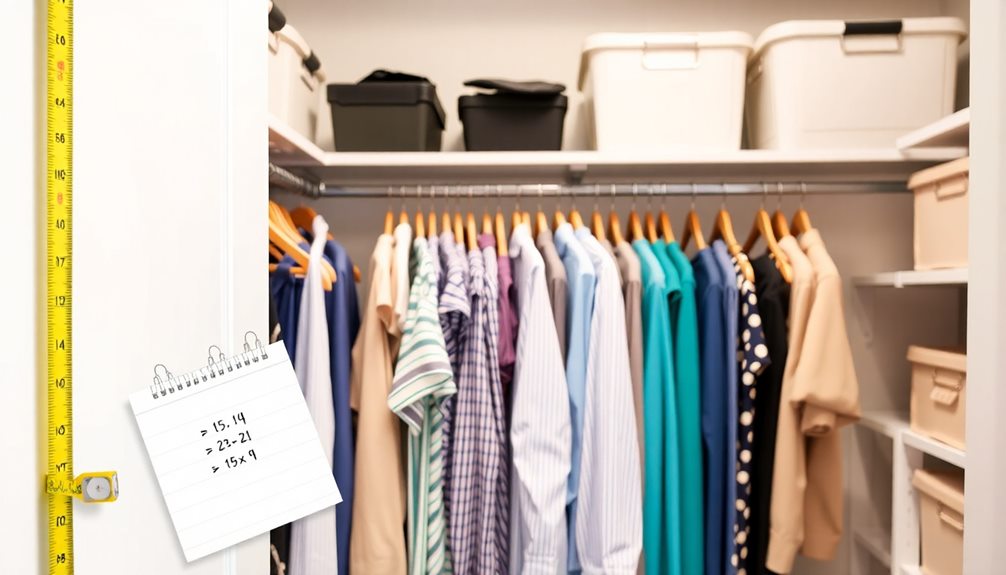
When it comes to measuring your closet space, getting precise dimensions is vital for effective organization. Start by measuring the back wall and both side walls to determine the total width and height available for your storage options.
Don't forget to deduct 1.5 inches from the back wall measurement to account for the thickness of the side walls when you're calculating shelf support lengths.
Next, measure the height from the floor to the ceiling. This will help you figure out how many shelves can fit and where you might want to place hanging rods. A typical closet depth is around 24 inches, so make sure to measure that as well to guarantee accessibility for your shelves and rods.
Using a tape measure, record all measurements carefully, as this information will be critical for optimizing your closet organizer's functionality.
Designing Your Closet System
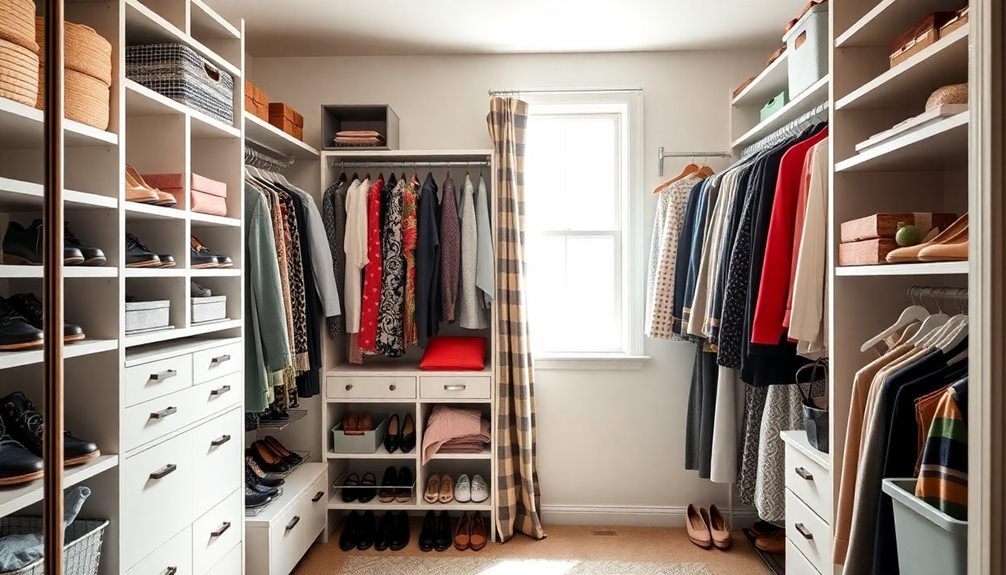
With your closet measurements in hand, you can now focus on designing a system that maximizes your space. Start by planning a variety of storage options, such as DIY closet shelves for folded clothes, rods for hanging items, and cubbies for shoes or accessories. This guarantees each item has a designated spot, making your closet organizer simple and efficient.
Consider implementing vertical storage solutions to further enhance your closet's functionality and keep the floor clear of clutter.
To visualize your layout, use painter's tape on the closet wall. This helps you confirm the placement and dimensions of your shelves and rods before proceeding. Consider incorporating adjustable shelves to accommodate different item sizes and make the most of your vertical space. This feature allows for easy reconfiguration as your storage needs change.
When selecting materials, opt for durable options like hardwood or high-quality plywood. These choices will ensure your customizable closet not only looks great but also stands the test of time.
With thoughtful planning and the right materials, you'll create a functional and attractive closet system that reflects your style and meets your storage needs. Start designing today, and transform your closet into a space that works for you!
Cutting and Preparing Materials

Before you start cutting, make certain you select the right materials and measure your closet dimensions accurately.
Accurate measurements are essential to guarantee that everything fits together perfectly. Once you've got that down, you can use efficient cutting techniques to prepare your materials for assembly.
Selecting Appropriate Materials
Choosing the right materials is vital for your DIY closet organization project. Start with MDF boards for the primary structure of your closet systems. They're sturdy yet cost-effective, making them perfect for building shelves and cubbies.
Here are three key steps to prepare your materials:
- Cutting: Use a miter saw or circular saw for precise cuts. Always double-check your measurements to avoid mistakes that could throw off your entire design.
- Pocket Holes: For a durable assembly, consider using a Kreg Jig to create pocket holes. This technique guarantees a strong and clean connection between the boards, enhancing the overall stability of your closet system.
- Sanding: After cutting, sand the edges and surfaces of all pieces to eliminate any splinters. This step is vital for achieving a smooth finish that's safe to handle and ready for painting.
Accurate Measurements Importance
Accurate measurements serve as the foundation for a successful DIY closet organization project. They guarantee that your system fits perfectly within the available space, preventing gaps or overcrowding.
Start by measuring the back wall and side walls, remembering to deduct 1.5 inches from the back wall measurement to account for the thickness of the side walls.
Using painter's tape to visualize your layout on the closet wall is a smart move. It allows you to confirm placements before you cut any materials.
Make certain to record all measurements meticulously, as this consistency is essential during the cutting and assembly process. By keeping everything documented, you'll reduce the likelihood of errors, which can be frustrating and time-consuming.
Regularly double-check your measurements against the cut pieces. This practice guarantees precision and maintains the integrity of your overall design.
Following these step-by-step instructions won't only help you achieve a polished look but also make the assembly process smoother.
Efficient Cutting Techniques
Efficient cutting techniques are vital for achieving a polished DIY closet organization project. To guarantee clean, precision cuts when cutting MDF, you'll want to use a miter saw or a circular saw. These tools help enhance the overall stability of your closet system.
Here are three significant tips to keep in mind:
- Measure Twice, Cut Once: Always double-check your measurements before making any cuts. Mark the wood clearly to avoid mistakes, particularly when considering the thickness of the MDF.
- Use Painter's Tape: Applying painter's tape along the cutting line helps guide your saw and reduces splintering on the edges, guaranteeing smoother finishes.
- Cut Outdoors: Since cutting MDF generates significant dust, it's best to wear a respirator and perform your cuts outdoors whenever possible for a safer environment.
Pre-cutting all shelf-size boards before assembly can save you time and minimize the amount of cutting needed during construction.
Assembly Techniques for Stability
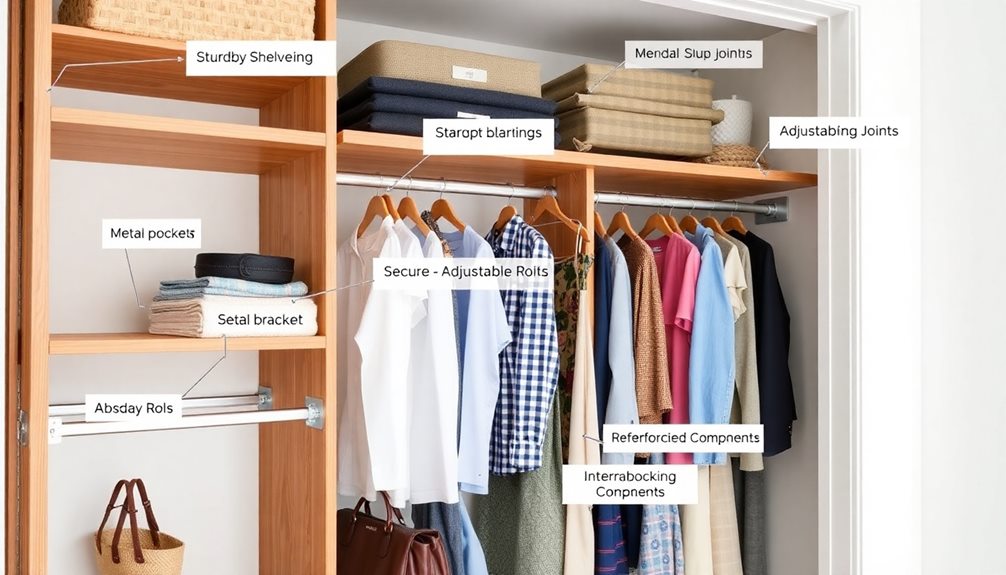
To guarantee your DIY closet organization system stands the test of time, focus on robust assembly techniques that prioritize stability. Start by utilizing pocket screws and a Kreg Jig to create reinforced joints, which is a smart approach similar to the importance of savings goals in financial planning. This assures a sturdy assembly capable of supporting heavy items on your shelves.
Incorporate vertical boards as side supports, securing them with nails and screws to establish a stable framework for your closet system.
While assembling, use a carpenter's square to check for squareness. This simple step prevents misalignment that could compromise structural integrity. For added stability, attach your shelves with wood glue in addition to screws. This creates a stronger bond, greatly reducing the likelihood of sagging over time.
Once your closet system is installed, don't forget to regularly inspect and tighten screws. This ongoing maintenance helps maintain stability and assures your organization system remains secure.
Painting and Finishing Touches
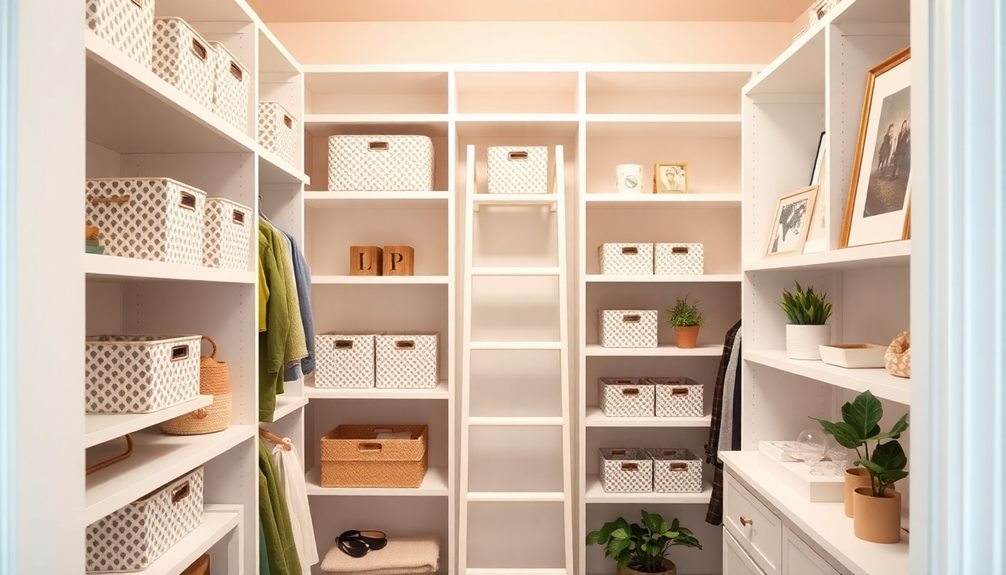
When it comes to painting your closet organization system, starting with loose boards before installation saves you time and effort.
Once everything's assembled, don't forget to apply a final coat to achieve that polished, cohesive look.
Using painter's tape will help you create clean lines, so your finished product looks sharp and professional.
Pre-installation Painting Techniques
Painting your closet components before installation can streamline the entire process and guarantee a flawless finish. By focusing on pre-painting efficiency, you'll save time and secure an even application, especially in hard-to-reach areas.
Here are three key tips to keep in mind:
- Remove Shoe Shelves: Take out shoe shelves for painting before adding the outer trim. This allows you to paint without obstruction, achieving a much cleaner finish.
- Access Difficult Areas: Pre-paint areas that might be tricky to reach once installed, like corners and behind supports. This will enhance the overall look of your closet and make it much easier to maintain.
- Final Touches: After installation, plan for trim painting separately. This ensures proper adhesion and helps create a cohesive finish with the rest of your closet organizer.
Once you've caulked and spackled, applying a final coat of paint will elevate the entire appearance, giving your closet system that professional touch.
Final Trim Application Tips
With the right approach, applying trim to your closet organization system can elevate the overall look and functionality of your space. Start by measuring and cutting your 1×2 boards carefully to guarantee a snug fit around shelves and cubbies. This attention to detail enhances the aesthetics of your organization system.
Next, use caulk to fill any gaps between the trim and the wall or shelves. Not only does this improve visual appeal, but it also helps prevent dust accumulation. For a polished finish, sand the edges of the trim before applying paint. This step guarantees a smooth surface that enhances paint adhesion and overall appearance.
Consider using high-quality paint or primer designed for wood surfaces. This choice provides better durability and a professional look. After painting, allow adequate drying time before reassembling any components to prevent smudging and guarantee your finish remains intact.
| Step | Action |
|---|---|
| Measure & Cut | Guarantee snug fit |
| Caulk Gaps | Fill spaces for a clean look |
| Sand Edges | Smooth surface for paint adhesion |
| Use Quality Paint | Enhances durability and appearance |
| Allow Drying Time | Prevents smudging |
Tips for Maximizing Storage
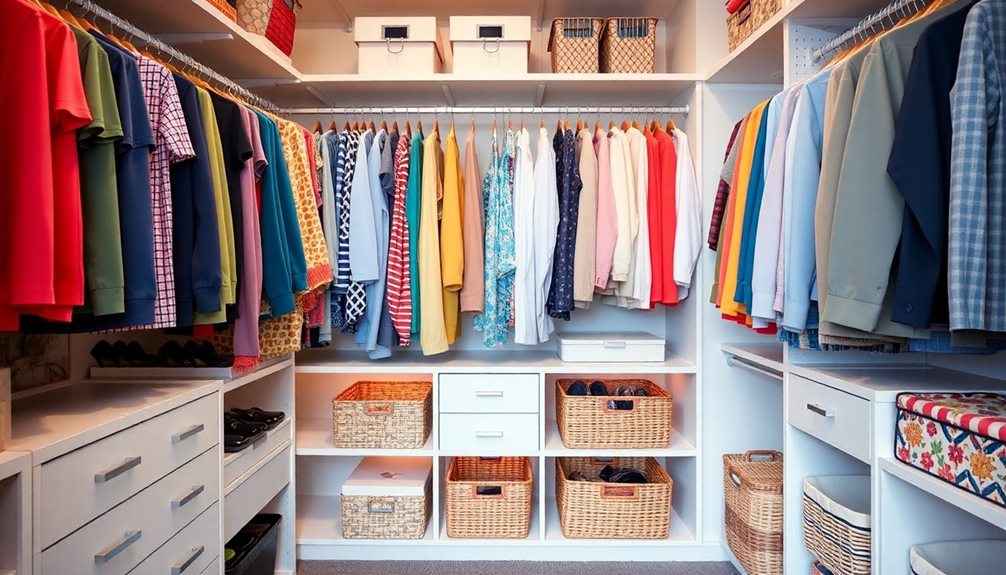
Maximizing storage in your closet is all about thinking vertically and using every inch efficiently.
Start by incorporating clever DIY Closet Organization Ideas that utilize your available space. Here are three effective tips to enhance your closet organization:
- Over-the-Door Organizers: Install over-the-door organizers or hanging shelves. They greatly increase storage capacity without sacrificing valuable floor space. You'll be amazed at how much you can fit!
- Drawer Dividers: Implement drawer dividers to compartmentalize accessories, socks, and undergarments. This not only enhances organization but also reduces clutter, making it easier to find what you need quickly.
- Seasonal Rotation: Rotate seasonal clothing using storage bins or vacuum bags to free up space for current items. This guarantees easy access to what you wear most and keeps your closet looking tidy.
Community Insights and Feedback
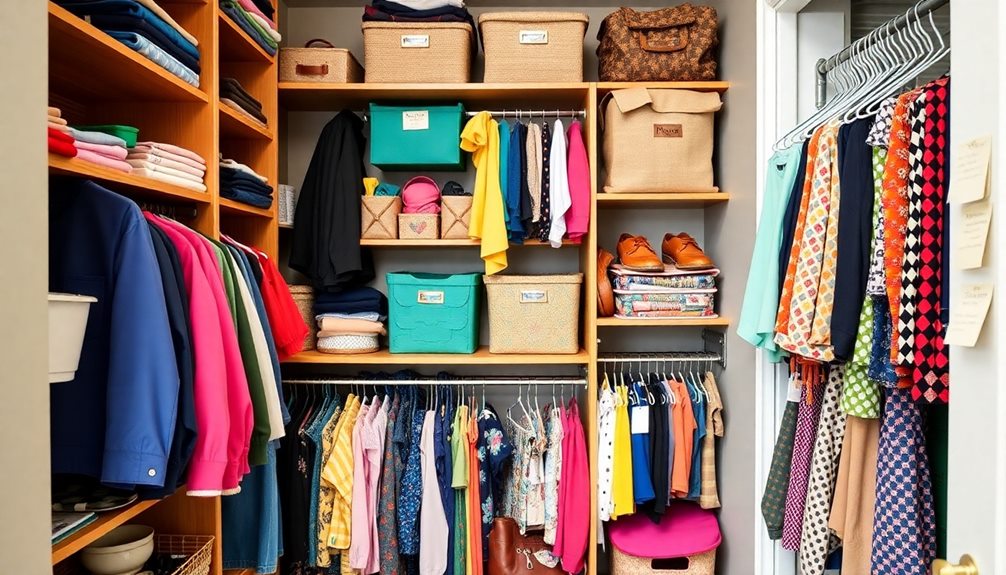
Many community members are enthusiastic to share their personal experiences and innovative solutions for DIY closet organization. This supportive environment encourages you to engage in your own projects, whether you're crafting cubbies and storage or exploring unique organizing techniques.
You'll find that many users highlight the cost-effectiveness of DIY systems compared to store-bought alternatives, which can save you money while allowing for customization. Feedback from fellow DIYers often stresses how satisfying and efficient their daily routines become after implementing personalized closet solutions.
They share tips on everything from selecting materials to assembly techniques, making it easier for both beginners and experienced organizers to tackle their own projects. Community discussions are filled with gratitude for shared insights, which not only inspire creativity but also foster a collaborative spirit.
As you interact with others, you'll notice recurring themes of innovation and practicality in closet organizing. These shared experiences motivate you to start on your own DIY journey, armed with valuable information from those who've walked the path before you.
Safety Tips for DIY Projects
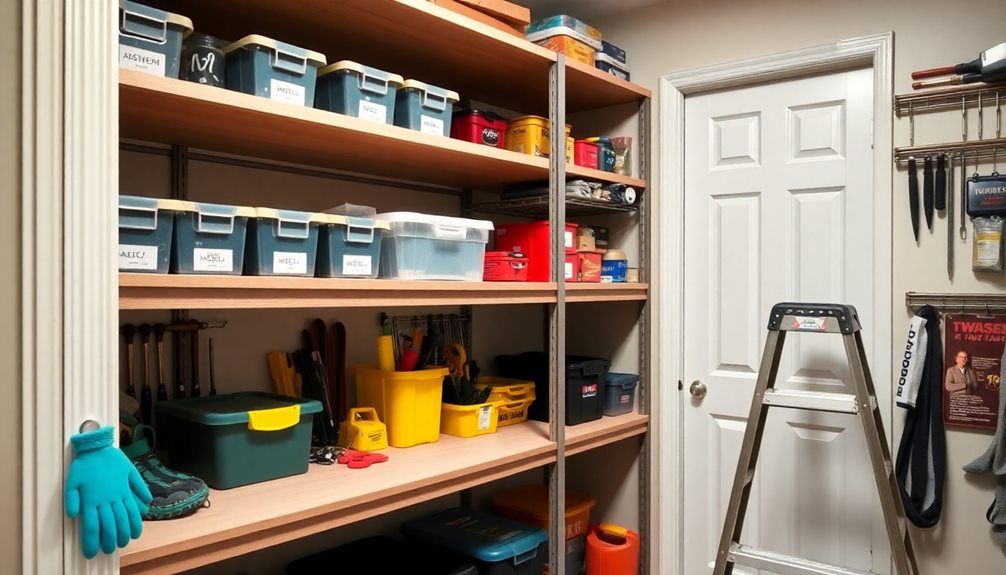
When diving into DIY projects, prioritizing safety is vital to guarantee a smooth and enjoyable experience. By following a few key safety tips, you can protect yourself and minimize potential hazards.
- Wear safety glasses and a dust mask: Always wear safety glasses and a dust mask when cutting materials, especially MDF. This protects your eyes and lungs from harmful dust particles.
- Maintain a clean workspace: A clean workspace is essential. Keeping your area organized reduces the risk of accidents and minimizes tripping hazards. Make sure tools and materials are neatly stored when not in use.
- Keep a first aid kit handy: Accidents can happen, so always have a first aid kit on hand for minor injuries. Familiarize yourself with its contents and know how to use them effectively.
Additionally, make sure your tools are regularly inspected and maintained for safe operation. Check for frayed cords on power tools and ensure blades are sharp and properly installed.
Frequently Asked Questions
Is It Cheaper to Build Your Own Closet System?
Yes, it's cheaper to build your own system. You'll save considerably by choosing materials wisely and customizing dimensions. Plus, you'll eliminate labor costs, making it a cost-effective solution tailored to your needs.
What Is the Best DIY Closet System?
If you think a best closet system magically appears, think again! For true elegance, consider modular designs; they adapt to your whims. Incorporate vertical space and sturdy materials, and watch your chaos transform into organized bliss.
How Do You Make a Homemade Closet Organizer?
To make a homemade closet organizer, measure your space, use durable materials like plywood, assemble with pocket holes, incorporate adjustable shelves, and finish with paint or stain for a polished look. You'll love the results!
How Do I Organize My Closet With Too Much Stuff?
You might think organizing's overwhelming, but it doesn't have to be! Start by purging unworn items, then use vertical storage and clear bins to maximize space. Rotate seasonal clothes regularly, keeping everything accessible and tidy.
Conclusion
Creating your own closet organization system not only saves you money but also allows you to customize the space to fit your needs. Did you know that an organized closet can increase your productivity by up to 30%? By following the steps outlined, you can transform your cluttered closet into a functional haven. Remember, the time and effort you invest now will pay off in efficiency and peace of mind every day. So, get started and enjoy your newly organized space!
Xavier – Your Operations Partner Xavier is your operations partner, working tirelessly behind the scenes to ensure that everything runs smoothly so you can enjoy a seamless experience with Perfect Fit Living. From managing inventory to coordinating logistics, he’s committed to making your experience with us hassle-free.
Home Improvement
Home Weatherization: Season-by-Season Checklist
Discover essential seasonal tasks for home weatherization that can transform your energy efficiency—find out what you might be missing!

To effectively weatherize your home, tackle seasonal tasks throughout the year. In spring, inspect your roof and service your heating system. Come summer, clean your HVAC and seal any gaps around windows. As fall arrives, prepare by checking your furnace and cleaning gutters. During winter, replace furnace filters monthly and insulate exposed pipes. Don't forget to maintain insulation year-round and schedule annual heating system inspections. These steps help improve energy efficiency, reduce heating costs, and enhance comfort. For more detailed tips and an in-depth checklist, you can uncover additional insights on seasonal weatherization strategies.
Key Takeaways
- Inspect and maintain insulation year-round to minimize heat loss and reduce heating costs by up to 20%.
- Clean and service HVAC systems every season to enhance performance and lower energy bills by 10-30%.
- Seal gaps around windows and doors to prevent drafts and save up to $160 annually on heating costs.
- Regularly clean gutters and downspouts to avoid water damage and ice dam formation, especially before winter.
- Schedule annual heating system inspections to ensure efficient operation and reduce energy consumption by 10-20%.
Spring Weatherization Tasks
As spring arrives, it's vital to tackle your weatherization tasks to guarantee your home is ready for the season. Start by inspecting your roof for any signs of wear, such as missing shingles or damage. This is critical for preventing leaks during the spring rain.
Next, check your gutters and downspouts to make certain they're clean and functioning properly. This helps prevent water pooling around your foundation, which can lead to costly repairs.
Don't forget to inspect your windows, too. Repair or replace any damaged screens to keep insects at bay as warmer weather approaches.
While you're at it, check your outdoor faucets for leaks and confirm they're in good working condition.
You should also take a moment to service your heating system; it's easier to do this now than when you need it again in the fall. Replace filters and check for leaks to guarantee the system's efficiency.
Finally, make sure your insulation is intact to keep the cold air out and the warm air in, helping your home stay comfortable.
With these tasks completed, you'll be well-prepared for the spring season.
Summer Maintenance Checklist

Maintaining your home during the summer months is vital for keeping it comfortable and efficient. Start by inspecting and cleaning your HVAC system to guarantee it runs at peak performance. A well-maintained unit can reduce your energy bills by 10-30%, which is especially helpful as you prepare for the winter months.
Additionally, consider the benefits of a heat pump, which can provide both heating and cooling efficiently with minimal environmental impact compared to conventional systems efficient heating and cooling. Don't forget to check and replace the HVAC filters every 1-3 months to maintain air quality and improve airflow.
Next, seal any gaps around windows and doors with caulk or weather stripping to prevent air leaks. This simple step can save you up to 20% on energy costs, making your home more efficient during winter.
It's also important to clean gutters and downspouts to make sure they're clear for summer storms. This prevents water damage and foundation issues, which can lead to costly repairs later.
Fall Preparation Steps

With summer maintenance complete, it's time to shift focus to preparing your home for the fall and winter months. This season is essential for preventing issues that can arise during colder weather.
Effective home insulation is key to maximizing your heating efficiency and comfort, especially if you consider integrating energy-efficient options like commercial grade heat pumps.
Here's a checklist to get you started:
- Clean gutters: Verify gutters and downspouts are clear to prevent ice dam formation, which can lead to roof leaks.
- Inspect furnace filters: Check and replace dirty filters to maintain peak airflow and efficiency. A clean filter can enhance heating effectiveness and reduce energy loss by up to 15%.
- Seal gaps: Look for cracks around windows and doors, and use caulk or weather stripping to seal them. This simple step can save you up to $160 a year on heating costs by minimizing drafts.
- Shut off the water: Drain garden hoses and shut off outdoor spigots to prevent freezing and potential pipe bursts.
Lastly, consider scheduling a professional inspection of your heating system to verify it operates efficiently, preventing unexpected breakdowns during peak winter usage.
Taking these steps now will help keep your home safe and comfortable all season long.
Winter Readiness Actions

Preparing your home for winter is essential to guarantee comfort and safety during the cold months. Start by inspecting and replacing your furnace filters monthly to enhance your heating system's efficiency and keep energy bills low. Seal drafty windows and doors with caulk and weather stripping to help prevent heat loss, which can account for up to 30% of your heating costs.
Next, clean your gutters regularly to avoid ice dams that can cause significant roof damage. Insulate pipes, especially those in unheated areas, to prevent frozen pipes that could burst and lead to costly repairs.
Finally, test your smoke detectors and carbon monoxide alarms. With longer nights during the winter months, ensuring these devices work is critical for your safety.
| Winter Readiness Actions | Importance |
|---|---|
| Inspect Furnace Filters | Boost heating efficiency |
| Seal Drafty Windows | Reduce heat loss |
| Insulate Pipes | Prevent costly damage |
Taking these steps will help keep your home safe and warm throughout the winter. Don't wait; start your winter readiness now!
Year-Round Best Practices

Your home's comfort and energy efficiency depend on consistent upkeep throughout the year. By implementing year-round best practices, you can effectively reduce heating costs and prevent damage.
Regular maintenance of systems like heat pumps can further enhance efficiency and prolong their lifespan, making it essential to understand features of the ultimate heat pump.
Here are four key actions to take:
- Inspect and Maintain Insulation: Regularly check your insulation to minimize heat loss. Inadequate insulation can cause up to 20% of your heating costs.
- Change HVAC Filters: Every three months, replace your HVAC filters. This simple step enhances airflow efficiency and can save you 5-15% on energy bills.
- Seal Drafts: Use caulk or weatherstripping around your windows and doors to seal drafts. Cold air infiltration can account for 30% of your home's heating energy use, so addressing this can markedly improve comfort.
- Clean Gutters and Schedule Inspections: Clean your gutters and downspouts seasonally to prevent ice dams and potential water damage.
Also, schedule annual inspections for your heating system to verify it operates efficiently, which can reduce energy consumption by 10-20%.
Frequently Asked Questions
How Often Should I Perform Weatherization Tasks Each Year?
You should perform weatherization tasks at least twice a year—once in spring and once in fall. This guarantees your home stays energy-efficient and comfortable, helping you save money on heating and cooling throughout the year.
What Tools Do I Need for Home Weatherization?
You'll need a caulking gun, weather stripping, insulation materials, a utility knife, a tape measure, a screwdriver, and safety gear. These tools help you seal drafts, insulate effectively, and guarantee your home stays energy-efficient year-round.
Can I Weatherize My Home Myself, or Should I Hire a Professional?
You can definitely weatherize your home yourself if you're handy and have the right tools. However, hiring a professional might save you time and guarantee everything's done correctly, especially for complex tasks.
How Does Weatherization Affect My Home's Resale Value?
Weatherization's like a warm hug for your home; it boosts energy efficiency and appeal. When potential buyers see reduced energy bills and comfort, they're more likely to pay a premium, enhancing your resale value greatly.
Are There Any Government Incentives for Weatherization Improvements?
Yes, there're government incentives for weatherization improvements. You can access tax credits, rebates, and grants that help reduce costs. Check local programs or the Department of Energy's website to find the best options available for you.
Conclusion
As you shift from the vibrant blooms of spring to the crisp chill of winter, remember that weatherization isn't just about survival; it's about comfort and efficiency year-round. While summer's heat may tempt you to ignore your home's needs, fall's colors remind you to prepare for the cold. Embrace each season's unique challenges, and you'll find that a well-weatherized home not only protects you from the elements but also enhances your living experience throughout the year.
Xavier – Your Operations Partner Xavier is your operations partner, working tirelessly behind the scenes to ensure that everything runs smoothly so you can enjoy a seamless experience with Perfect Fit Living. From managing inventory to coordinating logistics, he’s committed to making your experience with us hassle-free.
Home Improvement
Indoor Air Quality Improvement: Complete Guide
Transform your home’s air quality with essential tips and strategies that will leave you wondering what you’ve been missing for a healthier living space.
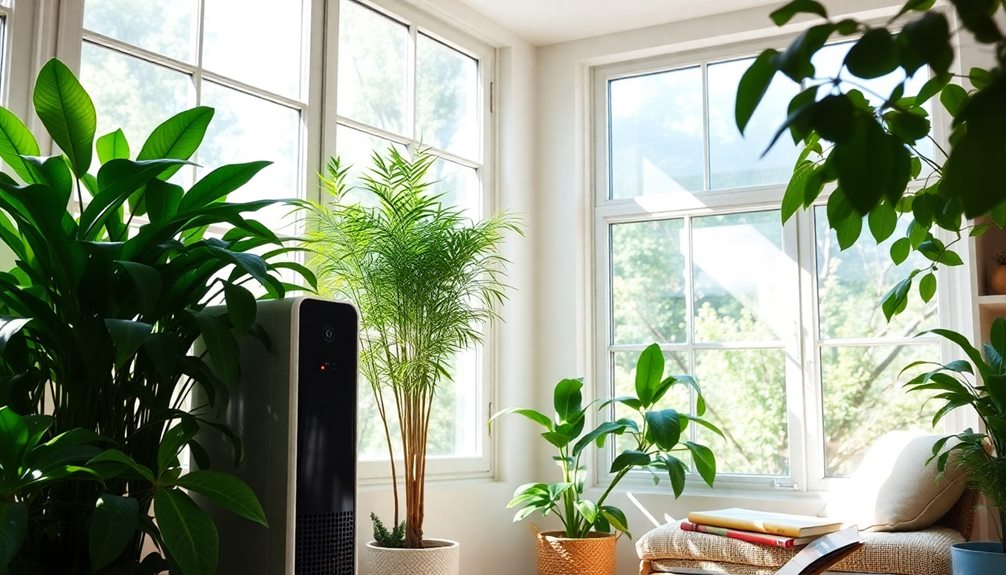
Improving your indoor air quality is essential for a healthier home. First, identify common pollutants like VOCs, carbon monoxide, and mold, which can affect your health. You can then take steps such as using air purifiers with HEPA filters, increasing ventilation, and maintaining humidity between 30-50%. Incorporating indoor plants can naturally purify the air too. Regular monitoring can help you stay on top of potential issues. Consider professional services for tasks like duct cleaning and mold remediation to further enhance your indoor environment. Discover how these strategies can transform your space into a fresher and healthier haven.
Key Takeaways
- Poor indoor air quality can lead to serious health issues; thus, maintaining clean air is crucial for respiratory and cognitive health.
- Utilize HEPA filters and activated carbon filters in air purifiers to effectively capture airborne pollutants and enhance air quality.
- Maintain indoor humidity levels between 30-50% to prevent mold growth and reduce allergens, improving overall health and comfort.
- Regularly monitor air quality using specialized devices to identify pollutants and inform necessary improvements for a healthier environment.
- Implement proper ventilation methods, such as using exhaust fans and opening windows, to dilute and remove indoor air contaminants.
Importance of Indoor Air Quality
Indoor air quality (IAQ) plays an essential role in your overall health and well-being, with studies showing that poor IAQ can lead to serious respiratory issues and cognitive decline.
Since you spend about 90% of your time indoors, ensuring the air you breathe is clean is vital. High levels of indoor air pollutants, often exacerbated by inadequate ventilation and everyday activities, can greatly impact your health, leading to long-term issues like heart disease and even cancer.
Regular use of air purifiers can help capture harmful pollutants like smoke and VOCs, thereby improving overall indoor air quality and contributing to better respiratory health.
Proper ventilation is key to reducing these pollutants and maintaining a safe indoor environment. The U.S. Environmental Protection Agency (EPA) emphasizes that effective management of IAQ not only protects against respiratory issues but also fosters a comfortable and productive living or working space.
By taking steps to improve air quality—such as using air purifiers, ensuring proper airflow, and controlling moisture—you can minimize harmful pollutants and create a healthier atmosphere.
air purifiers can greatly improve health
Common Indoor Air Pollutants
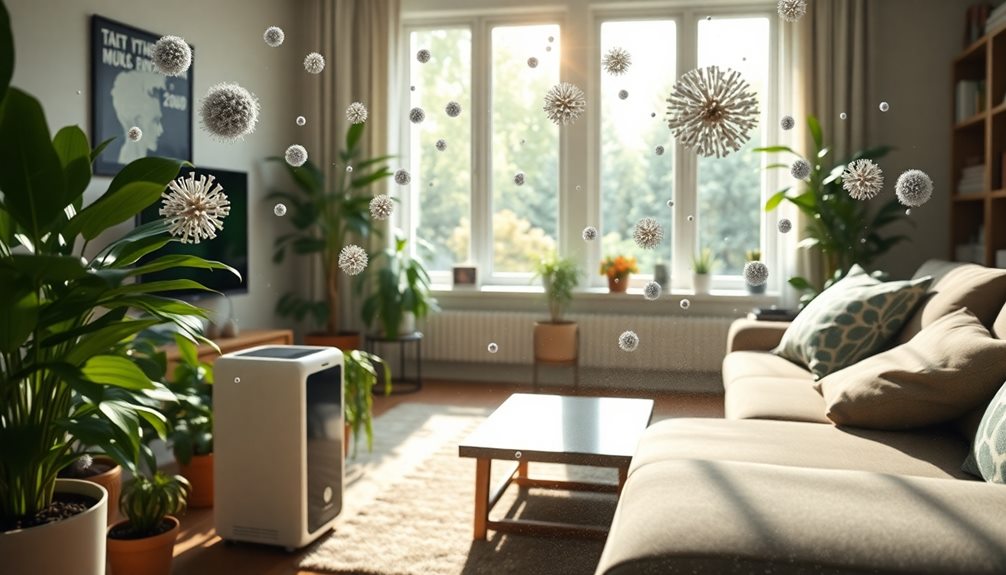
Maintaining good indoor air quality is closely tied to understanding the common pollutants that can compromise it. By recognizing these contaminants, you can take steps to minimize their impact on your health and well-being. Here's a quick overview of some of the most prevalent indoor air pollutants:
| Pollutant | Source | Health Effects |
|---|---|---|
| Volatile Organic Compounds (VOCs) | Household products (paints, cleaners) | Eye, nose, and throat irritation; long-term health issues |
| Carbon Monoxide | Gas appliances, combustion sources | Impaired oxygen delivery; serious health risks |
| Particulate Matter | Dust, mold, pet dander | Respiratory problems; allergic reactions |
| Biological Contaminants | Bacteria, viruses, mold | Respiratory infections; allergic reactions |
| Radon Gas | Naturally occurring radioactive gas | Leading cause of lung cancer among non-smokers |
Strategies for Air Quality Improvement

To improve your indoor air quality, you can focus on air purification techniques, effective ventilation methods, and humidity control solutions.
Utilizing air purifiers with HEPA filtration can greatly enhance your air quality by capturing allergens and pollutants. By using air purifiers and maintaining proper airflow, you'll greatly reduce airborne pollutants.
Additionally, managing humidity levels helps create a healthier environment, making it easier for you and your family to breathe comfortably.
Air Purification Techniques
Improving indoor air quality is vital for a healthier living environment, and employing effective air purification techniques can make a notable difference. Here are some strategies you can implement:
- Use HEPA Filters: Air purifiers equipped with HEPA filters capture up to 99.97% of airborne contaminants as small as 0.3 microns. They're effective at reducing allergens and pollutants in your home.
- Incorporate Activated Carbon Filters: These filters adsorb volatile organic compounds (VOCs) and odors, greatly enhancing your air quality.
- Perform Regular Maintenance: To guarantee peak performance, replace filters every 6 to 12 months. This regular maintenance is essential for continued air purification benefits.
- Add Indoor Plants: Consider incorporating plants like peace lilies and spider plants. They naturally help purify the air by absorbing toxins and increasing oxygen levels.
Additionally, UV light air purifiers can eliminate up to 99% of airborne bacteria and viruses, particularly useful in high-traffic areas.
Effective Ventilation Methods
Air quality doesn't just rely on purification techniques; effective ventilation plays a major role in creating a healthier indoor environment. Proper ventilation is essential for reducing indoor air pollutants, helping to dilute and remove contaminants that can adversely affect your health.
Studies show that the presence of security systems can enhance overall safety and peace of mind; similarly, proper ventilation systems contribute to a secure and healthy home environment the value of home security systems.
Utilizing exhaust fans in kitchens and bathrooms effectively removes moisture and pollutants generated from cooking and bathing, preventing mold growth and maintaining healthy humidity levels.
You can further enhance your indoor air quality (IAQ) by opening windows strategically for cross-ventilation, allowing fresh outdoor air to enter and lowering concentrations of indoor pollutants.
For a more thorough solution, consider whole-house ventilation systems like energy recovery ventilators (ERVs). These systems provide continuous airflow while minimizing energy loss, ensuring a steady supply of fresh air without compromising your heating or cooling efficiency.
The EPA recommends ventilating your home with outdoor air at a rate of at least 0.35 air changes per hour to promote adequate air exchange.
Humidity Control Solutions
Maintaining ideal humidity levels is essential for a healthy indoor environment. Keeping indoor humidity between 30%-50% helps prevent mold growth and reduces allergens like dust mites, which thrive in more humid settings.
Here are some effective humidity control solutions you can implement:
- Use Dehumidifiers: If you live in a humid climate, dehumidifiers can effectively lower moisture levels, improving air quality and reducing the likelihood of mold and mildew.
- Monitor Humidity Levels: Regularly check humidity levels with hygrometers. This allows you to take proactive measures to adjust indoor humidity as needed, enhancing comfort and health.
- Ensure Proper Ventilation: Utilize exhaust fans in kitchens and bathrooms to expel excess moisture generated from cooking and bathing activities. This is vital for controlling indoor humidity.
- Optimize HVAC Systems: Incorporate humidity control features in your HVAC systems. This not only improves air quality but also supports energy efficiency, potentially lowering utility costs.
Role of Ventilation
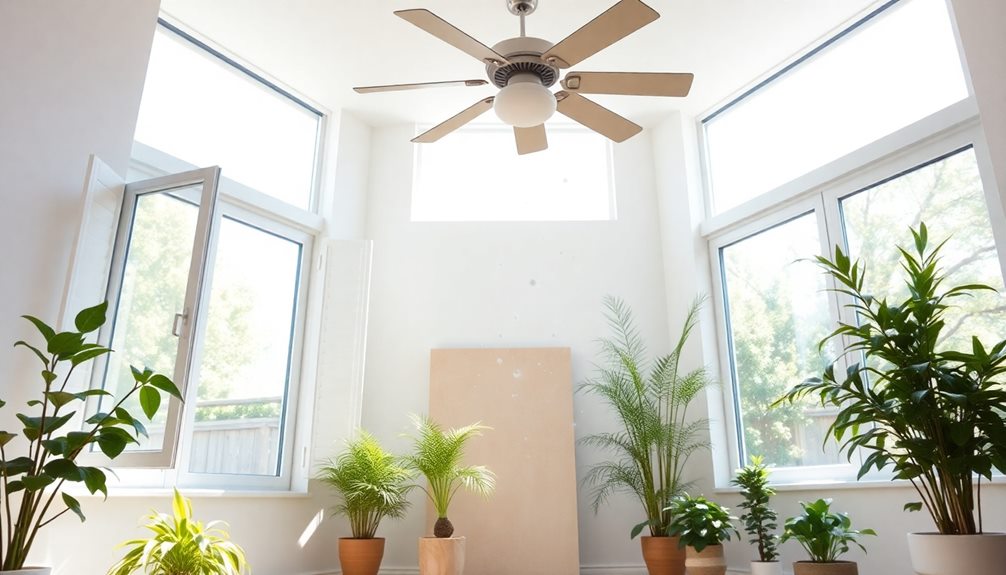
Ventilation plays an essential role in ensuring healthy indoor environments. By bringing in fresh outdoor air and expelling stale air, proper ventilation effectively dilutes indoor pollutants, greatly improving your indoor air quality (IAQ).
The EPA recommends achieving about 0.35 air changes per hour for homes to minimize indoor air pollution levels. Without adequate ventilation, you might notice higher carbon dioxide levels, which can lead to cognitive impairment, drowsiness, and headaches.
To enhance your ventilation, consider installing exhaust fans in bathrooms and kitchens. These fans are vital for removing excess moisture and odors, which helps prevent mold growth while improving overall air quality.
If you're looking for a more thorough solution, whole-house ventilation systems, such as heat recovery ventilators (HRVs) or energy recovery ventilators (ERVs), can be highly effective. They exchange stale indoor air with filtered outdoor air while minimizing energy loss, ensuring you breathe cleaner air throughout your home.
Impact of Humidity Control
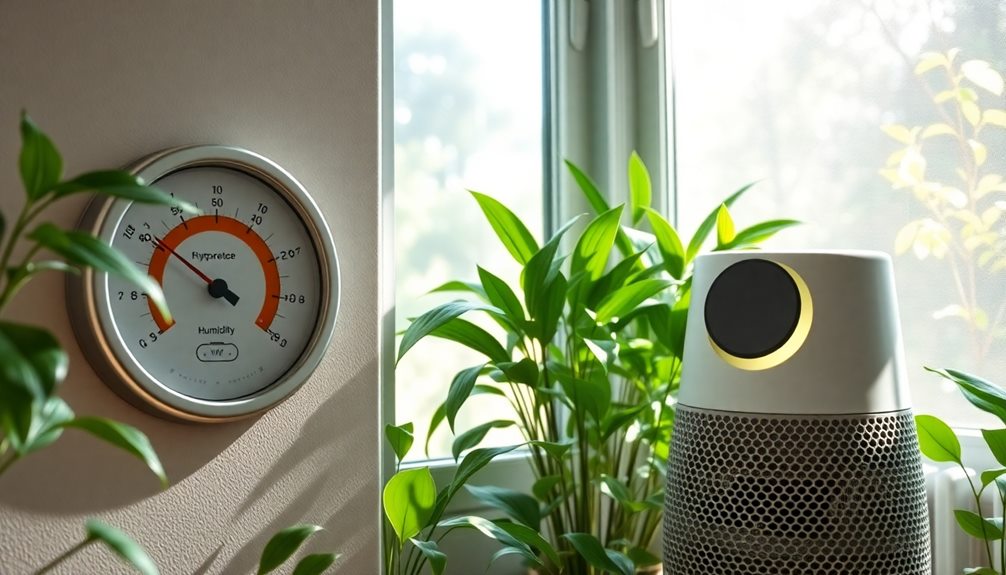
Controlling humidity in your home is essential for preventing mold and maintaining a healthy environment.
When you keep humidity levels between 30-50%, you not only enhance comfort but also protect your belongings from moisture damage.
Understanding the ideal humidity levels can make a significant difference in your indoor air quality and overall well-being.
Humidity and Mold Prevention
Humidity's impact on indoor environments can't be overstated; it plays an essential role in mold prevention.
Keeping humidity levels between 30% and 50% is vital because mold thrives in higher humidity. By effectively managing humidity, you can enhance indoor air quality and protect your respiratory health.
Here are some key strategies for humidity and mold prevention:
- Use Dehumidifiers: Place dehumidifiers in damp areas to lower humidity levels below 60%, effectively preventing mold development.
- Monitor Humidity: Regularly check humidity levels with hygrometers to make timely adjustments that maintain a comfortable environment.
- Reduce Allergen Presence: Lowering humidity can lead to a 30% reduction in dust mites and other allergens, improving overall indoor air quality.
- Maintain Ventilation: Guarantee proper ventilation in areas like bathrooms and kitchens to prevent moisture accumulation that can foster mold growth.
Comfort and Health Benefits
Effective humidity management not only prevents mold and allergens but also brings significant comfort and health benefits. Maintaining indoor humidity levels between 30-50% is vital for reducing the growth of mold, dust mites, and other pollutants that can harm your respiratory health.
When humidity is too high, it can make your space feel warmer, increasing your reliance on air conditioning and driving up energy costs. On the other hand, ideal humidity levels enhance your overall thermal comfort, making your home more enjoyable.
Moreover, proper humidity control can boost your cognitive function and productivity. Studies show that discomfort from high humidity can negatively impact your performance in work and learning environments.
It's important to keep your indoor environment balanced to avoid respiratory issues associated with poor indoor air quality (IAQ).
Using dehumidifiers or effective ventilation systems can help you maintain this balance, reducing excess moisture that can cause structural damage, such as wood rot and insulation issues.
Optimal Humidity Levels
Maintaining indoor humidity levels between 30% and 50% is essential for creating a comfortable and healthy living environment.
Ideal humidity levels help you avoid issues caused by high humidity, such as mold growth and dust mites, while also preventing the discomfort associated with low humidity.
Effective humidity control can greatly enhance your indoor air quality (IAQ) and overall well-being.
Here's how you can maintain ideal humidity levels:
- Use Hygrometers: Regularly monitor humidity levels in your home to verify they stay within the ideal range.
- Install Dehumidifiers: Use these in damp areas to help reduce indoor pollutants and manage excess moisture effectively.
- Maintain HVAC Systems: Proper humidity control can improve the efficiency of your HVAC systems, saving you money on energy costs.
- Promote Air Circulation: Open windows when weather permits to allow fresh air in, which can also help balance humidity levels.
Benefits of Air Purifiers

Improving indoor air quality with air purifiers brings a host of benefits that can greatly enhance your living environment. Air purifiers with HEPA filters can capture up to 99.97% of airborne particles, effectively reducing allergens like dust, pollen, and pet dander. This means you can breathe easier, especially if you suffer from respiratory issues or allergies.
These devices also help to improve indoor air quality by considerably decreasing levels of Volatile Organic Compounds (VOCs) and other harmful pollutants. As a result, your overall health outcomes can improve, leading to better sleep quality and enhanced cognitive function.
By reducing airborne irritants, air purifiers create a more comfortable living space, allowing you to focus and relax. Additionally, some models are designed to eliminate odors and harmful gases, providing a fresher indoor atmosphere.
Continuous operation of air purifiers can lead to noticeable reductions in asthma symptoms and respiratory discomfort, making them valuable tools for individuals with pre-existing health conditions. Investing in an air purifier can truly transform your home into a safer, healthier haven.
Indoor Plants for Air Quality

Indoor plants can be a powerful ally in enhancing air quality within your home. By strategically choosing certain indoor plants, you can greatly improve indoor air quality and create a healthier indoor environment. Here's how:
- Toxin Absorption: Plants like peace lilies and spider plants effectively absorb harmful air pollutants such as formaldehyde and benzene.
- Oxygen Production: Incorporating indoor plants can reduce carbon dioxide levels, increasing oxygen production for a fresher atmosphere.
- Humidity Regulation: Indoor plants naturally help maintain humidity levels between 30-50%, which is essential for preventing mold and dust mites.
- Mental Well-Being: Studies show that having plants indoors can lower stress levels and uplift your mood, contributing to improved mental well-being.
Additionally, NASA's Clean Air Study found that certain houseplants can remove up to 87% of indoor air pollutants in just 24 hours, showcasing their effectiveness as a natural air purification method.
Monitoring Indoor Air Quality

Ensuring a healthy living environment hinges on effectively monitoring indoor air quality (IAQ). By utilizing air quality monitors, you can track levels of common indoor pollutants like VOCs, particulate matter, and carbon monoxide. This real-time data empowers you to make informed decisions that can lead to better health outcomes.
Regular assessments help identify these pollutants and highlight actions needed, such as enhancing proper ventilation or incorporating air purifiers. The EPA recommends routine testing for radon and carbon monoxide due to their considerable health risks.
Advanced monitoring systems can also integrate with HVAC controls, optimizing air quality by adjusting ventilation rates based on detected pollutant levels. This not only improves your indoor environment but also boosts energy efficiency.
Moreover, continuous IAQ monitoring can have a profound impact on cognitive function. Studies show that better air quality correlates with enhanced mental performance, particularly in work and educational settings.
Professional Services for IAQ
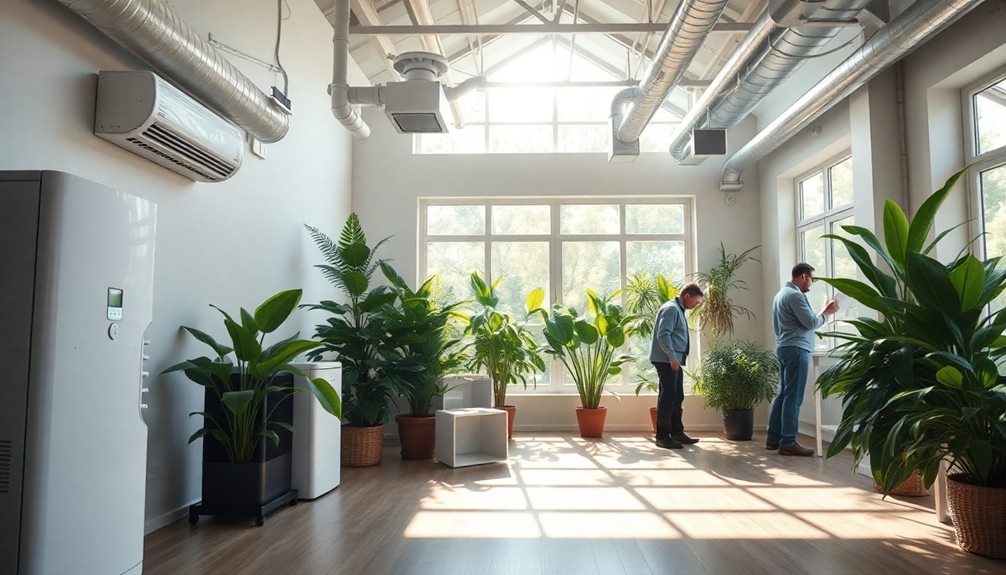
Professional services for improving indoor air quality (IAQ) can make a significant difference in your home's environment. By engaging these services, you can guarantee a healthier living space for you and your family.
Here are some essential professional services to take into account:
- Air Duct Cleaning: This removes dust and allergens from your ducts, enhancing air circulation and quality throughout your home.
- Mold Remediation: Eliminating mold growth is vital, as it can lead to serious health issues, including respiratory problems and allergies.
- HVAC Maintenance: Regular maintenance by certified professionals keeps your system running efficiently, preventing indoor pollutants from accumulating.
- IAQ Monitoring and Air Quality Testing: These services assess pollutant levels, including radon and carbon monoxide, guaranteeing a safe indoor environment.
Investing in these professional services not only improves your indoor air quality but also contributes to your overall well-being.
By prioritizing air quality, you create a more comfortable and healthier home for everyone.
Don't wait—take action today to enhance your indoor air quality!
Frequently Asked Questions
How Often Should I Change My HVAC Filters?
You should change your HVAC filters every one to three months, depending on your system and usage. If you have pets or allergies, consider checking them monthly to maintain good air quality in your home.
Can Pets Affect Indoor Air Quality?
You might notice your friend's cat shedding fur everywhere, which can worsen indoor air quality. Pets do affect it by releasing dander and allergens, so regular cleaning and grooming can help minimize their impact.
What Are the Signs of Poor Indoor Air Quality?
You might notice signs of poor indoor air quality like persistent odors, increased allergy symptoms, excessive dust, or frequent headaches. If these issues arise, it's time to investigate and improve your indoor environment.
Is It Safe to Use Scented Candles Indoors?
Using scented candles indoors can add a cozy atmosphere, but you should be cautious. They can release soot and volatile organic compounds. Opt for natural alternatives or guarantee good ventilation to enjoy their charm safely.
How Does Mold Impact Indoor Air Quality?
Mold can markedly impact indoor air quality by releasing spores and allergens that you inhale. It can lead to respiratory issues, allergic reactions, and other health problems, so addressing any mold issues in your space is essential.
Conclusion
Improving indoor air quality isn't just a task; it's a transformative journey toward healthier living. By tackling toxins, enhancing airflow, and embracing eco-friendly solutions, you can create a sanctuary of serenity. With simple strategies like adding air-purifying plants or using purifiers, you'll breathe easier and feel better. So, take charge today—don't delay! Prioritize your well-being and foster fresh, fabulous air in your home, because you deserve to dwell in a delightful, dynamic environment.
Xavier – Your Operations Partner Xavier is your operations partner, working tirelessly behind the scenes to ensure that everything runs smoothly so you can enjoy a seamless experience with Perfect Fit Living. From managing inventory to coordinating logistics, he’s committed to making your experience with us hassle-free.
-

 Vetted5 months ago
Vetted5 months ago14 Best Personalized Father's Day Gifts for Your Husband – Show Him You Care
-

 Alfresco5 months ago
Alfresco5 months agoAlfresco Stacker Doors: Seamless Indoor-Outdoor Living!
-

 Vetted6 months ago
Vetted6 months ago15 Best EMS Foot Massagers for Neuropathy to Soothe Your Feet
-

 Craft and Textiles7 months ago
Craft and Textiles7 months ago15 Best Places to Buy Appliances for Your Home – Top Retailers Reviewed
-
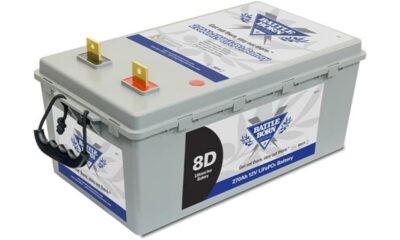
 Vetted5 months ago
Vetted5 months agoBattle Born Batteries Review: Reliable Power Solution
-
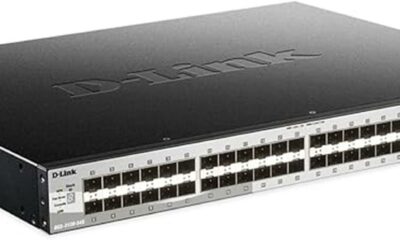
 Vetted5 months ago
Vetted5 months agoD-Link Switch Review: Lite Layer 3 Managed Networking
-

 Tableware and Dining Accessories7 months ago
Tableware and Dining Accessories7 months agoWhat Is the Meaning of the Word Tableware
-

 Tableware and Dining Accessories7 months ago
Tableware and Dining Accessories7 months agoWhat Is the Hindi Meaning of Tableware





























